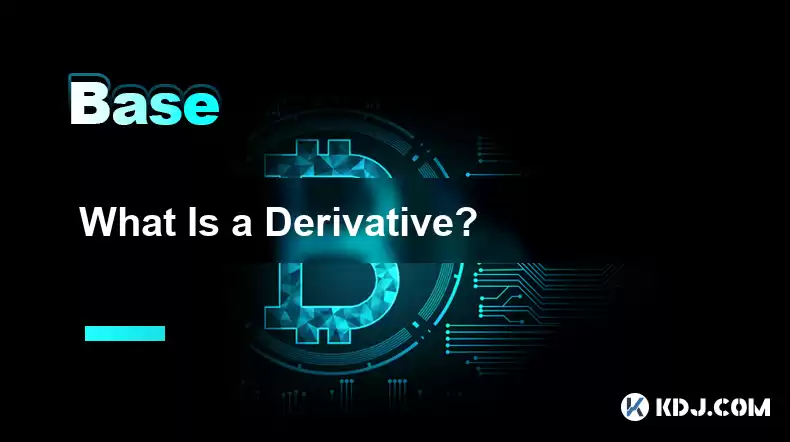-
 bitcoin
bitcoin $102182.982207 USD
-0.92% -
 ethereum
ethereum $3438.744518 USD
0.12% -
 tether
tether $0.999933 USD
0.02% -
 xrp
xrp $2.405093 USD
0.05% -
 bnb
bnb $956.306114 USD
-0.53% -
 solana
solana $153.028851 USD
-1.23% -
 usd-coin
usd-coin $0.999800 USD
-0.03% -
 tron
tron $0.294898 USD
-1.08% -
 dogecoin
dogecoin $0.171428 USD
-0.58% -
 cardano
cardano $0.551186 USD
-1.15% -
 hyperliquid
hyperliquid $38.755878 USD
0.04% -
 chainlink
chainlink $15.298460 USD
-0.05% -
 bitcoin-cash
bitcoin-cash $516.067428 USD
1.68% -
 stellar
stellar $0.280726 USD
-0.42% -
 zcash
zcash $518.919369 USD
18.01%
What Is a Derivative?
Derivatives, financial instruments linked to underlying assets, offer exposure to price movements without ownership rights, enabling hedging, speculation, and arbitrage.
Dec 16, 2024 at 08:47 pm

- Definition of a derivative
- Types of derivatives: forwards, futures, options, and swaps
- Uses of derivatives for hedging, speculation, and arbitrage
- Basic concepts of derivative pricing
- Risks and complexities associated with using derivatives
A derivative is a financial instrument that derives its value from an underlying asset or set of assets. Unlike stocks or bonds, which represent ownership or debt obligations, derivatives do not convey any ownership rights. Instead, they provide exposure to the price movements of the underlying asset without requiring direct ownership.
Types of Derivatives:- Forwards: Legally binding contracts to buy or sell an asset at a predetermined price on a future date.
- Futures: Standardized contracts traded on exchanges for the future delivery of an asset at a set price.
- Options: Contracts giving the holder the right, but not the obligation, to buy or sell an asset at a specific price by a certain date.
- Swaps: Agreements to exchange cash flows based on different interest rates, currencies, or other variables.
- Hedging: To protect against price fluctuations in the underlying asset. For example, a farmer can use a futures contract to lock in a selling price for their crops ahead of harvest, reducing the risk of price declines.
- Speculation: To profit from price movements in the underlying asset. Traders may speculate on the future value of a commodity or security without owning the actual asset.
- Arbitrage: To exploit price differences between different markets for the same underlying asset. For example, an arbitrageur may simultaneously buy and sell an asset in two different exchanges if it is trading at a higher price in one market than the other.
The price of a derivative is determined by several factors, including:
- Underlying asset price: The price of the asset that the derivative is based on.
- Time to maturity: The amount of time left until the derivative expires or is exercised.
- Volatility: The expected fluctuations in the underlying asset price.
- Risk-free interest rate: The rate at which money can be borrowed or invested with no risk.
Derivatives are powerful financial instruments but can also be complex and risky. Potential risks include:
- Price volatility: Derivatives can amplify the price movements of the underlying asset, leading to significant losses.
- Margin requirements: Traders often use margin to trade derivatives, which can increase their potential losses.
- Counterparty risk: Derivatives involve contracts with other parties, introducing the risk of default if the counterparty cannot fulfill its obligations.
- What is the difference between a forward and a futures contract?
- Forwards are customized contracts tailored to specific parties, while futures are standardized contracts traded on exchanges.
- What are the four basic types of options?
- Calls (right to buy), puts (right to sell), long calls (obligation to buy), and long puts (obligation to sell).
- What is a synthetic swap?
- A derivative contract that mimics the cash flows of a swap but is constructed using other derivatives, such as options or futures.
- What are the regulatory requirements for derivatives trading?
- Derivatives are subject to various regulations, including reporting, clearing, and margin requirements, to mitigate risks and protect investors.
Disclaimer:info@kdj.com
The information provided is not trading advice. kdj.com does not assume any responsibility for any investments made based on the information provided in this article. Cryptocurrencies are highly volatile and it is highly recommended that you invest with caution after thorough research!
If you believe that the content used on this website infringes your copyright, please contact us immediately (info@kdj.com) and we will delete it promptly.
- Token Listing Mania: Attention Turns to BANK, MET, and the Rise of Meme Coin Utility
- 2025-11-14 01:00:01
- Pi Network's Web3 Gaming Ecosystem: A New Dawn or Just Hype?
- 2025-11-14 01:20:01
- Hashgraph, Tokenization, and Hedera (HBAR): A New Era for Real-World Assets?
- 2025-11-14 01:10:02
- Aztec Network Revolutionizes Token Sales with Uniswap Auction: A New Era of Privacy and Fairness
- 2025-11-13 23:45:01
- Bodega Cat Memecoin War in San Francisco: From Tragedy to Crypto Craze
- 2025-11-13 23:50:01
- Amboss, Bitcoin Payments, and Voltage Partner: Revolutionizing Enterprise Transactions
- 2025-11-13 23:10:01
Related knowledge

What is the difference between a transparent and a shielded transaction?
Nov 10,2025 at 05:59pm
Understanding Transparent Transactions in Cryptocurrency1. Transparent transactions are the standard form of transaction on most public blockchains li...

What is a "crypto airdrop farmer" and what strategies do they use?
Nov 09,2025 at 03:39pm
What Is a Crypto Airdrop Farmer?1. A crypto airdrop farmer is an individual who actively participates in blockchain projects to qualify for free token...

What is an unspent transaction output (UTXO) and how does Bitcoin use it?
Nov 12,2025 at 01:40am
Understanding the Concept of Unspent Transaction Output (UTXO)1. An Unspent Transaction Output, commonly referred to as UTXO, is a fundamental compone...

How do you track a crypto portfolio across multiple wallets and chains?
Nov 12,2025 at 04:19pm
The Evolution of Decentralized Exchanges in the Crypto Ecosystem1. Decentralized exchanges (DEXs) have transformed how users trade digital assets by r...

How does a crypto insurance protocol work?
Nov 08,2025 at 12:39am
Understanding Crypto Insurance Protocols1. A crypto insurance protocol operates by offering financial protection against losses incurred from digital ...

What is token composability and why is it called "DeFi Legos"?
Nov 09,2025 at 06:39am
Bitcoin's Role in Decentralized Finance1. Bitcoin remains the cornerstone of decentralized finance, serving as a benchmark for value and trustlessness...

What is the difference between a transparent and a shielded transaction?
Nov 10,2025 at 05:59pm
Understanding Transparent Transactions in Cryptocurrency1. Transparent transactions are the standard form of transaction on most public blockchains li...

What is a "crypto airdrop farmer" and what strategies do they use?
Nov 09,2025 at 03:39pm
What Is a Crypto Airdrop Farmer?1. A crypto airdrop farmer is an individual who actively participates in blockchain projects to qualify for free token...

What is an unspent transaction output (UTXO) and how does Bitcoin use it?
Nov 12,2025 at 01:40am
Understanding the Concept of Unspent Transaction Output (UTXO)1. An Unspent Transaction Output, commonly referred to as UTXO, is a fundamental compone...

How do you track a crypto portfolio across multiple wallets and chains?
Nov 12,2025 at 04:19pm
The Evolution of Decentralized Exchanges in the Crypto Ecosystem1. Decentralized exchanges (DEXs) have transformed how users trade digital assets by r...

How does a crypto insurance protocol work?
Nov 08,2025 at 12:39am
Understanding Crypto Insurance Protocols1. A crypto insurance protocol operates by offering financial protection against losses incurred from digital ...

What is token composability and why is it called "DeFi Legos"?
Nov 09,2025 at 06:39am
Bitcoin's Role in Decentralized Finance1. Bitcoin remains the cornerstone of decentralized finance, serving as a benchmark for value and trustlessness...
See all articles










































































